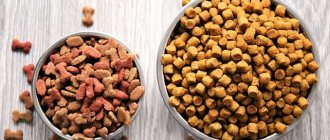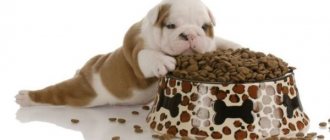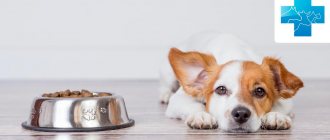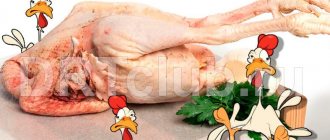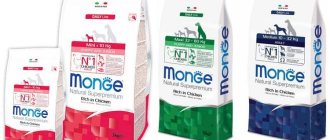Many dog owners, when choosing between dry ready-made food and natural food that they have to prepare with their own hands, prefer the first option. After all, industrial feed has a number of significant advantages:
Photo: dry dog food | Dreamstime.com
- Save time.
Simply pour the required amount of dry granules into the animal’s bowl. But feeding “naturally” requires a significant amount of time spent on purchasing food and preparing meals; - High-quality food
is a balanced product. Whereas when feeding self-prepared foods, it is very difficult to calculate whether the animal receives all the vitamins and microelements in abundance; - Almost all dogs love ready-made dry food.
But it can be difficult to feed the same vegetables to a dog, but without fiber; - Ready-made food does not spoil for a long time.
For comparison: boiled meat up to + 6 degrees is stored for no more than 48 hours, and chilled meat at a temperature not higher than + 4 degrees – 7-10 days; - In a good food, all components benefit the dog.
When feeding “natural” food, it can be difficult to consider which foods can be given to your pet and which cannot (for example, dogs should absolutely not be treated to sausages, mushrooms, citrus fruits, fatty meats, etc.).
The benefits of “drying” are great. But the decision to switch the dog to dry food must be made by the owner himself.
When may it be necessary to switch your dog to dry food?
There are a number of reasons why a loving owner switches his four-legged pet to ready-made diets. Statistics show that among the most common are:
- Lack of free time. Work and long trips around the city take up a huge amount of time. The owner simply does not have the opportunity to purchase fresh, high-quality natural products to feed the dog;
- Lack of experience in creating a varied and balanced menu;
- The appearance of various diseases in the animal, which require a specialized diet. It is almost impossible to prepare such food on your own;
- Frequent travel of the owner and his pet. Finding fresh food on the road and creating a balanced diet is not easy.
Be sure to read our article: Which is better: Dry dog food or natural? All pros and cons
There are many reasons for making such a decision as switching your dog to a ready-made diet. And it is extremely important to do this as gently as possible so that her digestive system does not suffer.
Gradualism is the key to victory
Separation from the mother and moving are already a serious test for a puppy, so try to make the change in feeding as smooth as possible. Find out what the baby was fed at the breeder's house, and for the first days stick to a similar menu, even if you understand that it is incorrect. During this period, you will already have a difficult time: most likely, the baby will be sad, worried and looking for his mother.
As soon as the puppy adapts at home, start introducing him to the new food. Try offering pellets by hand as a reward first. For example, when you teach a new family member the simplest commands: “Place”, “Come” and others. Dogs have an excellent memory for smells. In the future, when the puppy smells the aroma of food, he will associate it exclusively with praise and pleasant emotions.
If your pet willingly eats from your hands, try going further and completely replacing one feeding with “drying”. In this case, the granules can be pre-soaked in warm water so that they more closely resemble the natural food familiar to the puppy in appearance and consistency. On the second day, replace another feeding with dry food, and so on, until you completely transfer the baby to the new diet.
Normally, such a transition should take 5–7 days. Do not try to speed it up, otherwise the animal may have problems with digestion. The same applies to cases when it is necessary to switch the dog to another brand of ready-made food.
Rules for transferring to dry food
Veterinarians remind us that when transferring an animal from a natural diet to ready-made diets, it is necessary to adhere to several very important rules:
- Choose only quality products. You should not give preference to economy class products. In 99% of cases, a low price is achieved by introducing a large amount of soy, corn and other ingredients that are of little use to the animal into the granules. Experts recommend choosing premium food or mixtures belonging to the holistic category;
- Consult your veterinarian first. This will allow you to assess the pet’s health status and select the optimal menu among the quality diets available on the domestic market;
- Do not rush. Ideally, the duration of transferring a dog to another type of food should not be less than 14 days. It is this period of time that is necessary for a healthy pet to gradually adapt to unusual food and not have problems with the gastrointestinal tract;
- Individual approach. Not every dog can easily give up a juicy piece of meat and happily switch to dry kibble. Be patient and give your pet time to get used to it. Excessive persistence of the owner can lead to negative consequences.
This is important: Breeders should remember that there are several taboos that should not be ignored. These prohibitions have a completely scientific explanation and are designed to preserve the health of animals.
So, it is not recommended to switch pets to dry food:
- Whose age exceeds 5-7 years. In this case, the digestive system is simply not able to adapt to the new menu and there is a high risk of developing chronic inflammatory processes in the intestines, pancreatitis and other equally unpleasant diseases;
- Puppies until they reach the age of 4-5 months. During this period, active development of all organs of the digestive system occurs. And by the age of 5 months, the pancreas produces a sufficient amount of enzymes for the puppy to adapt to dry food;
- Abruptly remove familiar natural products from the animal’s diet. There is a high risk of causing psychological trauma to the dog, because new food is not always accepted easily. And the pet is sure that the owner simply refuses to feed him;
- Leave the usual amount of water. Dry kibble swells in the dog's stomach. That's why she drinks heavily. And if the breeder leaves the amount of water in the bowl the same as during natural feeding, then the dog becomes thirsty as a result of a lack of fluid;
- Add vitamin and mineral complexes after transferring the dog to ready-made premium mixtures. It is important to remember that good quality dry food contains a balanced amount of all essential substances. Therefore, additional administration of vitamins will lead to the development of hypervitaminosis. And it is just as dangerous for your pet, as is a lack of vitamins and minerals.
By following these simple rules, every owner will make the transition of their pet from natural products to dry high-quality mixtures painless and comfortable.
Pay attention to our article: Transferring a dog from dry food to natural food. Veterinarian advice
Useful tips
Few people know that dehydrated pieces of meat in the diet of animals appeared 160 years ago in 1860. There is still debate about the disadvantages and advantages of this product.
Feed selection
Only those owners who purchased economy-class products for their pets could have a clearly negative opinion about industrial food. It contains components that are useless for regular consumption: soy, cereals, offal instead of meat. The attractive aroma of the lumps is created using chemical flavors and flavor enhancers.
When choosing a product, you should give preference only to high-quality products and a trusted manufacturer. It is important to carefully study the composition on the packaging. The following components should be listed there:
- fresh and dehydrated meat;
- eggs;
- vegetables and fruits, sometimes seaweed;
- fish fat;
- amino acids;
- cereals;
- vitamin and mineral complex.
Eating such granules will not only not harm your pet, but will also bring him benefit and satiation. Super-premium and holistic products do not require additional vitamins and microelements to be added to the menu.
We must not forget about the age and size of the individual. For example, a small breed dog or an elderly individual is unlikely to cope with large pieces of food intended for large breeds of animals.
Drinking regime
When using “drying”, the animal needs constant access to clean drinking water more than ever. It is necessary for the balance of nutrients in the body and normal digestion. Water should be next to the food plate so that your friend can quench his thirst not only after eating, but at any time.
Scheme for transferring a dog from natural to dry food
Veterinarians recommend adhering to a certain regimen that will make the process of switching to ready-made diets more gentle on the digestive system.
Thus, the following ratio of natural products and dry granules should be observed:
- 1-5 days 75% nat. Products: 25% granules;
- 6-10 days 50% nat. Products:50% granules;
- 10-15 days 25% nat. Products: 50% granules;
- From 16 days 100% ready-made dry diets.
This is important: Experts remind you not to mix fresh ingredients and dry food in the same bowl. The only exceptions are those pets who flatly refuse to even try drying. In this case, you can mix a small amount of granules into the usual diet so that the dog gets used to their taste. In other cases, dry food is given in the morning, and natural food in the evening. Or vice versa.
You may also find our article useful: Is it possible to combine dry dog food and natural food?
Maintain drinking regime
Even if you soaked the granules at first, it is advisable to move away from this practice in the future. Firstly, because chewing hard food is more physiological for dogs and puts stress on the teeth and gums. Secondly, soaked food quickly deteriorates and becomes weathered. If dry granules can be offered to your pet again, then moistened ones quickly become unattractive even for a hungry dog.
As soon as the puppy begins to receive new food in dry form (without pre-soaking), he will begin to drink more. This is completely natural, because now he hardly consumes liquid with food. Just make sure that clean, fresh water is always available. If the contents of the bowl become cloudy due to saliva, do not be lazy to refresh it again.
Some animals prefer to endure thirst rather than drink muddy water, which can lead to dehydration. There are various automatic drinking bowls on the pet supply market, including those with a water supply connection. They provide the animal with clean and fresh water even in the absence of the owner.
What to do if your dog refuses dry food?
Perplexed breeders often turn to veterinarians or experienced dog handlers with this question.
The answer is simple. Perhaps the pet does not like the taste or aroma of the menu chosen by the owner. Therefore, you should not immediately buy a large package of unusual food. Offer the picky person a different taste. It is likely that the animal will like “Cold Meat” more than “Rabbit with Turkey” or vice versa.
A good solution would be to mix a small amount of granules into your usual food. This way the dog will gradually get used to the new taste and aroma. The transition process will be somewhat delayed, but will be smoother.
Monitor your health status
Problems with stool, allergies, anxiety, lethargy, weight loss or intense gain - all these signs indicate that the chosen food is not suitable for the animal.
You should buy your pet a product from the same manufacturer with a different base (for example, beef instead of chicken) or completely change the brand. New food should also be introduced gradually to monitor the reaction to it.
How to switch a dog from one dry food to another?
Sometimes the dog refuses his favorite food for several days. Don't insist. It is much easier to change the usual diet for high-quality dry food. If the initiator of such a change was a dog who refuses to eat dry food, then everything goes much easier.
But what should owners do if, for some reason, they need to switch their pet to ready-made food from another manufacturer? For example, on a therapeutic diet? The animal does not always happily accept such a change in food.
Veterinarians recommend gradually adding new food to your usual food. The four-legged pet will get used to the new taste. The duration of the transition can range from several days to two weeks.
This is important: The owner should carefully monitor the dog's condition. Disturbances in the functioning of the digestive system (diarrhea, constipation, the appearance of mucus or blood in the stool, vomiting, apathy) and other alarming symptoms should be a reason to contact a specialist.
A veterinarian will help determine the cause of this condition of the animal and select the optimal diet, amount of food and brand of ready-made diet.
Feeding standards
It will be possible to finally transfer a healthy puppy from natural food to dry industrial food in a few months. During the first 30 days, you must remember to soak the granules.
It is preferable to divide the food into several times at the rate of 100 g of feed per 10 kg of body. Gradually increase the daily volume by 50 g per day. The share of natural food should not exceed 10% of the total food.

